Soccer Scoring Techniques: How Much Do We Know Them Biomechanically?—A State-of-the-Art Review
Abstract
1. Introduction
2. Scope and Inclusion/Exclusion Criteria
3. Identification of SSTs
| SST | Anatomical Parameters | Biomechanical Parameters |
|---|---|---|
| Bicycle kick | Foot, instep | Airborne ball, hit-on-center, vertical jump, trunk lean backward horizontally, forward kick |
| Jumping side volley | Foot, instep | Airborne ball, hit-on-center, vertical jump, trunk lean sideward horizontally, forward kick |
| Jumping front volley | Foot, instep | Airborne ball, hit-on-center, vertical jump, vertical trunk, forward kick |
| Long-jump turning header | Forehead | Airborne ball, hit-on-center, long jump, vertical trunk, head twisting |
| Diving header | Forehead | Airborne ball, hit-on-center, long jump, trunk lean forward horizontally |
| Diving scorpion kick | Foot, heel | Airborne ball, hit-on-center, long jump, trunk lean forward horizontally, backward kick |
| Trivela kick | Foot, outside | Ground ball, hit-on-side, no jump, vertical trunk, forward kick |
| Jumping turning kick | Foot, outside | Airborne ball, hit-on-center, vertical jump, vertical and twisting trunk |
| Jumping breaking kick | Foot, plantar side | Airborne ball, hit-on-center, long jump, vertical trunk |
| Sliding kick | Foot, plantar side | Ground ball, hit-on-center, no jump, trunk lean backward horizontally |
| Knuckleball kick | Foot, knuckle area | Ground ball, hit-on-center, no jump, vertical trunk, forward kick |
4. Biomechanical Aspects Governing SSTs
4.1. Temporal Factors Related to Shooting Effectiveness
4.2. Spatial Factors Related to Shooting Effectiveness
4.3. Quantification of Attackers’ Proprioceptive/Effective Shooting Volume
4.4. Focusing on Time in Space: A New Theoretical Framework That Integrates the Temporal and Spatial Factors
5. Current State of SST Research
5.1. Maximal-Instep Kick
5.2. Knuckleball Kick, Curl Kick, Trivela Kick, and Chip Kick
5.3. Header
5.4. Side Volley
5.5. Bicycle Kick
5.6. Jumping Side Volley
6. Challenges and Future Prospects
7. Conclusions
Funding
Institutional Review Board Statement
Informed Consent Statement
Data Availability Statement
Conflicts of Interest
References
- Garganta, J.; Maia, J.; Basto, F. Analysis of goal-scoring patterns in European top level soccer teams. In Science and Football III; E & F N Spon Ltd.: London, UK, 1997; pp. 246–250. [Google Scholar]
- Shan, G.; Zhang, X.; Wan, B.; Yu, D.; Wilde, B.; Visentin, P. Biomechanics of coaching maximal instep soccer kick for practitioners. Interdiscip. Sci. Rev. 2018, 44, 12–20. [Google Scholar] [CrossRef]
- Zhang, X.; Shan, G.; Liu, F.; Yang, S.; Meng, M. Diversity of Scoring, Ingenuity of Striking, Art of Flying—Conceptual and Systematical Identification of Soccer Scoring Techniques. Phys. Act. Rev. 2021, 9, 86–99. [Google Scholar] [CrossRef]
- Hyballa, P. The Art of Flying. Success Soccer 2002, 5, 19–26. [Google Scholar]
- Shan, G.; Zhang, X. Soccer Scoring Techniques—A Biomechanical Re-Conception of Time and Space for Innovations in Soccer Research and Coaching. Bioengineering 2022, 9, 333. [Google Scholar] [CrossRef] [PubMed]
- Shan, G.; Daniels, D.; Wang, C.; Wutzke, C.; Lemire, G. Biomechanical analysis of maximal instep kick by female soccer players. J. Hum. Mov. Stud. 2005, 49, 149–168. [Google Scholar]
- FIFATV. Every Nanosecond is Special. 2021. Available online: https://www.youtube.com/shorts/yGg3ff2iyd4 (accessed on 16 January 2022).
- Shan, G. Biomechanical Know-how of Fascinating Soccer-kicking Skills—3D, Full-body Demystification of Maximal Instep Kick, Bicycle kick & Side Volley. In Proceedings of the 8th International Scientific Conference on Kinesiology, Opatija, Croatia, 10–14 May 2017. [Google Scholar]
- Ballreich, R.; Baumann, W. Grundlagen der Biomechanik des Sports (The Basics of Biomechanics in Sports); Enke Verlag: Stuttgart, Germany, 1996. [Google Scholar]
- Liu, Y.; Kong, J.; Wang, X.; Shan, G. Biomechanical analysis of Yang’s spear turning-stab technique in Chinese martial arts. Phys. Act. Rev. 2020, 8, 16–22. [Google Scholar] [CrossRef]
- Visentin, P.; Shan, G.; Wasiak, E.B. Informing music teaching and learning using movement analysis technology. Int. J. Music Educ. 2008, 26, 73–87. [Google Scholar] [CrossRef]
- Yu, D.; Yu, Y.; Wilde, B.; Shan, G. Biomechanical characteristics of the Axe Kick in Tae Kwon-Do. Arch. Budo 2012, 8, 213–218. [Google Scholar] [CrossRef]
- Grant, M.J.; Booth, A. A typology of reviews: An analysis of 14 review types and associated methodologies. Health Inf. Libr. J. 2009, 26, 91–108. [Google Scholar] [CrossRef]
- Paré, G.; Trudel, M.-C.; Jaana, M.; Kitsiou, S. Synthesizing information systems knowledge: A typology of literature reviews. Inf. Manag. 2015, 52, 183–199. [Google Scholar] [CrossRef]
- LaLiga. TOP 20 Acrobaticos GOALS LaLiga Santander 2008/2009 to 2018/2019. 2020. Available online: https://www.youtube.com/watch?v=7aD4hN5nKxk (accessed on 16 July 2022).
- Bundesliga. Top 10 Best Acrobatic Goals of The Decade 2010-2019—Jovic, Lewandowski, Ribery & More. 2020. Available online: https://www.youtube.com/watch?v=0HBsGYyAcno (accessed on 17 July 2022).
- PremierLeague. STUNNING Acrobatic, Overhead & Bicycle Kick Goals | Premier League Edition. 2020. Available online: https://www.youtube.com/watch?v=UMcJAXwWaf0 (accessed on 16 July 2022).
- SerieA. AMAZING Overhead & Bicycle Kicks. 2020. Available online: https://www.youtube.com/watch?v=w_R2Y56b8mA (accessed on 17 July 2022).
- FIFA. FIFA Coaching Manual. 2017. Available online: https://premiersoccerinstitute.com/wp-content/uploads/2017/04/Fifa-Coaching-manual.pdf (accessed on 17 July 2018).
- Thömmes, F. Fußballtraining für Jeden Tag: Die 365 Besten Übungen; [+ 16 Seiten moderne Entwicklungstendenzen]; Stiebner Verlag GmbH: Grünwald, Germany, 2012. [Google Scholar]
- Bénézet, J.-M.; Hasler, H. Youth Football; Galledia AG: Berneck, Switzerland, 2017. [Google Scholar]
- FIFA. FIFA Introduces New FIFA Puskás Award to Honour the “Goal of the Year”. 2009. Available online: https://www.fifa.com/mensyoutholympic/news/y=2009/m=10/news=fifa-introduces-new-fifa-puskas-award-honour-the-goal-the-year-1120531.html (accessed on 16 January 2016).
- Magill, R.A. Motor Learning Concepts and Applications, 6th ed.; McGraw-Hill: Boston, MA, USA, 2001. [Google Scholar]
- Shan, G.; Visentin, P.; Zhang, X.; Hao, W.; Yu, D. Bicycle kick in soccer: Is the virtuosity systematically entrainable? Sci. Bull. 2015, 60, 819–821. [Google Scholar] [CrossRef]
- Zhang, X.; Shan, G.; Liu, F.; Yu, Y. Jumping Side Volley in Soccer—A Biomechanical Preliminary Study on the Flying Kick and Its Coaching Know-How for Practitioners. Appl. Sci. 2020, 10, 4785. [Google Scholar] [CrossRef]
- Hong, S.; Chung, C.; Sakamoto, K.; Asai, T. Analysis of the swing motion on knuckling shot in soccer. Procedia Eng. 2011, 13, 176–181. [Google Scholar] [CrossRef]
- Shinkai, H.; Smith, N. How to Kick the Knuckle Shot. In Football Biomechanics; Nunome, H., Hennig, E., Smith, N., Eds.; Routledge: New York, NY, USA, 2018; pp. 77–88. [Google Scholar]
- Reep, C.; Benjamin, B. Skill and Chance in Association Football. J. R. Stat. Soc. 1968, 131, 581. [Google Scholar] [CrossRef]
- Bate, R. Football Chance: Tactics and Strategy. In Science and Football; Routledge: New York, NY, USA, 1988. [Google Scholar]
- Hughes, M.; Franks, I. Analysis of passing sequences, shots and goals in soccer. J. Sports Sci. 2005, 23, 509–514. [Google Scholar] [CrossRef] [PubMed]
- Seabra, F.; Dantas, L.E. Space definition for match analysis in soccer. Int. J. Perform. Anal. Sport 2006, 6, 97–113. [Google Scholar] [CrossRef]
- Wright, C.; Atkins, S.; Polman, R.; Jones, B. Factors Associated with Goals and Goal Scoring Opportunities in Professional Soccer. Int. J. Perform. Anal. Sport 2011, 11, 438–449. [Google Scholar] [CrossRef]
- Durlik, K.; Bieniek, P. Analysis of goals and assists diversity in English Premier League. J. Health Sci. 2014, 4, 47–56. [Google Scholar]
- Shan, G. Influence of gender and experience on the maximal instep soccer kick. Eur. J. Sport Sci. 2009, 9, 107–114. [Google Scholar] [CrossRef]
- Shan, G.; Yuan, J.; Hao, W.; Gu, M.; Zhang, X. Regression equations for estimating the quality of maximal instep kick by males and females in soccer. Kinesiology 2012, 44, 139–147. [Google Scholar]
- Lees, A.; Asai, T.; Andersen, T.B.; Nunome, H.; Sterzing, T. The biomechanics of kicking in soccer: A review. J. Sports Sci. 2010, 28, 805–817. [Google Scholar] [CrossRef] [PubMed]
- Rodenas, J.G.; Malaves, R.A.; Desantes, A.T.; Ramirez, E.S.; Hervas, J.C.; Malaves, R.A. Past, present and future of goal scoring analysis in professional soccer. Retos 2020, 37, 774–785. [Google Scholar]
- Memmert, D.; Rein, R. Match analysis, big data and tactics: Current trends in elite soccer. Ger. J. Sports Med. 2018, 69, 65–72. [Google Scholar] [CrossRef]
- Pratas, J.; Volossovitch, A.; Carita, A.I. Goal scoring in elite male football: A systematic review. J. Hum. Sport Exerc. 2018, 13, 218–230. [Google Scholar] [CrossRef]
- Shan, G.; Zhang, X. From 2D leg kinematics to 3D full-body biomechanics-the past, present and future of scientific analysis of maximal instep kick in soccer. Sports Med. Arthrosc. Rehabil. Ther. Technol. 2011, 3, 23. [Google Scholar] [CrossRef]
- Sherrington, C.S. On the proprioceptive system, especially in its reflex aspect. Brain 1907, 29, 467–482. [Google Scholar] [CrossRef]
- Wong, J.D.; Kistemaker, D.A.; Chin, A.; Gribble, P.L. Can proprioceptive training improve motor learning? J. Neurophysiol. 2012, 108, 3313–3321. [Google Scholar] [CrossRef]
- Alsmith, A.J.; Longo, M.R. Where exactly am I? Self-location judgements distribute between head and torso. Conscious. Cogn. 2014, 24, 70–74. [Google Scholar] [CrossRef]
- Aman, J.E.; Elangovan, N.; Yeh, I.-L.; Ekonczak, J. The effectiveness of proprioceptive training for improving motor function: A systematic review. Front. Hum. Neurosci. 2015, 8, 1075. [Google Scholar] [CrossRef]
- Shan, G.; Bohn, C. Anthropometrical data and coefficients of regression related to gender and race. Appl. Ergon. 2003, 34, 327–337. [Google Scholar] [CrossRef]
- Winter, D.A. Biomechanics and Motor Control of Human Movement; John Wiley & Sons: Hoboken, NJ, USA, 2009. [Google Scholar]
- Wan, B.; Gao, Y.; Wang, Y.; Zhang, X.; Li, H.; Shan, G. Hammer Throw: A Pilot Study for a Novel Digital-Route for Diagnosing and Improving Its Throw Quality. Appl. Sci. 2020, 10, 1922. [Google Scholar] [CrossRef]
- Chang, S.T.; Evans, J.; Crowe, S.; Zhang, X.; Shan, G. An innovative approach for Real Time Determination of Power and Reaction Time in a Martial Arts Quasi-Training Environment Using 3D Motion Capture and EMG Measurements. Arch. Budo 2011, 7, 185–196. [Google Scholar]
- FIFATV. FIFA Puskas Award 2019 Nominee: Zlatan Ibrahimovic. 2019. Available online: https://www.youtube.com/watch?v=oV6L2cNr0MU (accessed on 11 June 2020).
- Roberts, E.M.; Metcalfe, A. Mechanical Analysis of Kicking. In Biomechanics; Karger Publishers: Basel, Switzerland, 1969; pp. 315–319. [Google Scholar]
- Plagenhoef, S.; Curtis, D. Patterns of Human Motion: A Cinematographic Analysis; Prentice Hall: Hoboken, NJ, USA, 1971. [Google Scholar]
- Zernicke, R.F.; Roberts, E.M. Lower extremity forces and torques during systematic variation of non-weight bearing motion. Med. Sci. Sports 1978, 10, 21–26. [Google Scholar] [PubMed]
- Asami, T. Analysis of Powerful Ball Kicking. In Biomechanics VIII-B; Human Kinetics: Champaign, IL, USA, 1983; pp. 695–700. [Google Scholar]
- Opavsky, P. An investigation of linear and angular kinematics of the leg during two types of soccer kick. In Science and Football; Reilly, T., Lees, A., Davids, K., Murphy, W., Eds.; E & FN Spon: London, UK, 1988; pp. 460–467. [Google Scholar]
- Luhtanen, P. Biomechanical Aspects in Football (Soccer); Ekblom, B., Ed.; Blackwell Scientific Publications: Oxford, UK, 1994. [Google Scholar]
- Lees, A.; Nolan, L. The biomechanics of soccer: A review. J. Sports Sci. 1998, 16, 211–234. [Google Scholar] [CrossRef] [PubMed]
- Shan, G.; Westerhoff, P. Full-body kinematic characteristics of the maximal instep soccer kick by male soccer players and parameters related to kick quality. Sports Biomech. 2005, 4, 59–72. [Google Scholar] [CrossRef]
- Rodano, R.; Tavana, R. Three dimensional analysis of the instep kick in professional soccer players. In Science and Football II; Reilly, T., Clarys, J., Stibbe, A., Eds.; E & FN Spon: London, UK, 1993; pp. 357–361. [Google Scholar]
- Reilly, T.; Cabri, J.; Araújo, D. The three-dimensional nature of the maximal instep kick in soccer. In Science and Football V; Reilly, T., Cabri, J., Araújo, D., Eds.; Routledge: London, UK, 2005; pp. 78–80. [Google Scholar]
- Lees, A.; Nolan, L. Three-dimensional kinematic analysis of the instep kick under speed and accuracy conditions. In Science and Football IV; Spinks, W., Reilly, T., Murphy, A., Eds.; Routledge: London, UK, 2002; pp. 16–21. [Google Scholar]
- Egan, C.D.; Verheul, M.H.G.; Savelsbergh, G.J.P. Effects of Experience on the Coordination of Internally and Externally Timed Soccer Kicks. J. Mot. Behav. 2007, 39, 423–432. [Google Scholar] [CrossRef]
- Stoner, L.; Ben-Sira, D. Variation in movement patterns of professional soccer players when executing a long range instep soccer kick. In Proceedings of the Seventh International Congress of Biomechanics, Warsaw, Poland, 20–24 July 1981. [Google Scholar]
- Tol, J.L.; Slim, E.; van Soest, A.J.; van Dijk, C.N. The relationship of the kicking action in soccer and anterior ankle impingement syndrome: A biomechanical analysis. Am. J. Sports Med. 2002, 30, 45–50. [Google Scholar] [CrossRef]
- Nunome, H.; Lake, M.; Georgakis, A.; Stergioulas, L.K. Impact phase kinematics of instep kicking in soccer. J. Sports Sci. 2006, 24, 11–22. [Google Scholar] [CrossRef]
- Texier, B.D.; Cohen, C.; Quéré, D.; Clanet, C. Physics of knuckleballs. New J. Phys. 2016, 18, 073027. [Google Scholar] [CrossRef]
- Bush, J.W. The aerodynamics of the beautiful game. In Sports Physics; Clanet, C., Ed.; Les Editions de l’Ecole Polytechnique: Paris, France, 2013; pp. 171–192. [Google Scholar]
- Hong, S.; Chung, C.; Nakayama, M.; Asai, T. Unsteady aerodynamic force on a knuckleball in soccer. Procedia Eng. 2010, 2, 2455–2460. [Google Scholar] [CrossRef][Green Version]
- Hong, S.; Kazama, Y.; Nakayama, M.; Asai, T. Ball impact dynamics of knuckling shot in soccer. Procedia Eng. 2012, 34, 200–205. [Google Scholar] [CrossRef][Green Version]
- Asai, T.; Carre, M.J.; Akatsuka, T.; Haake, S.J. The curve kick of a football I: Impact with the foot. Sports Eng. 2002, 5, 183–192. [Google Scholar] [CrossRef]
- Alcock, A.M.; Gilleard, W.; Hunter, A.B.; Baker, J.; Brown, N. Curve and instep kick kinematics in elite female footballers. J. Sports Sci. 2012, 30, 387–394. [Google Scholar] [CrossRef] [PubMed]
- Hall, S.J. Basic Biomechanics, 8e; McGraw-Hill: New York, NY, USA, 2019. [Google Scholar]
- Chanda, S.; Mondal, S.K. Study of relationship between kicked ball angle and kicking leg kinematics at the time of execution of chip shot of male soccer players. Indian J. Phys. Educ. Sports Appl. Sci. 2016, 2, 44975451. [Google Scholar]
- McLean, B.D.; Tumilty, D.M. Left-right asymmetry in two types of soccer kick. Br. J. Sports Med. 1993, 27, 260–262. [Google Scholar] [CrossRef] [PubMed]
- McCunn, R.; Beaudouin, F.; Stewart, K.; Meyer, T.; MacLean, J. Heading in football: Incidence, biomechanical characteristics and the association with acute cognitive function—A three-part systematic review. Sports Med. 2021, 51, 2147–2163. [Google Scholar] [CrossRef] [PubMed]
- Basinas, I.; McElvenny, D.M.; Pearce, N.; Gallo, V.; Cherrie, J.W. A Systematic Review of Head Impacts and Acceleration Associated with Soccer. Int. J. Environ. Res. Public Health 2022, 19, 5488. [Google Scholar] [CrossRef]
- Kristensen, L.; TAndersen, B.; S⊘rensen, H. Soccer: Optimizing Segmental Movement in the Jumping Header in Soccer. Sports Biomech. 2004, 3, 195–208. [Google Scholar] [CrossRef]
- Marcolin, G.; Petrone, N. A method for the performance evaluation of jumping headers in soccer. In Proceedings of the 24th International Symposium on Biomechanics in Sports, Salzburg, Austria, 14–18 July 2006. [Google Scholar]
- Gu, F. Biomechanics analysis of side header in soccer players. In Proceedings of the 2016 6th International Conference on Machinery, Materials, Environment, Biotechnology and Computer, Tianjin, China, 11–12 June 2016; Atlantis Press: Paris, France, 2016. [Google Scholar]
- Bagatin, R.T. The bicycle and side volley kicks in soccer: A systematical review. RBFF-Rev. Bras. Futsal Futeb. 2019, 11, 314–318. [Google Scholar]
- Chiu, Y.H.; Wong, T.L.; Wang, J.C.; Lin, C.H. The analysis of angular Momentum of Side-Volley soccer shots performed at three ball-height. In Proceedings of the 23rd International Symposium on Biomechanics in Sports, Beijing, China, 22–27 August 2005. [Google Scholar]
- Sugi, S.; Nunome, H.; Tamura, Y.; Iga, T. Kinematics of low, middle and high volley kicking in soccer. In Proceedings of the 34th International Symposium on Biomechanics in Sports, Tsukuba, Japan, 18–22 July 2016. [Google Scholar]
- Kostić, S.; Ilić, D.; Mrdaković, V. Invariance of Motor Patterns in Side Volley Kick in Football; Fakulteta Sporta i Fizičkog Vaspitanja: Belgrade, Serbia, 2013; pp. 48–65. [Google Scholar]
- Newell, K.; Walter, C. Kinematic and kinetic parameters as information feedback in motor skill acquisition. J. Hum. Mov. Stud. 1981, 7, 235–254. [Google Scholar]
- Adams, J.A. Historical review and appraisal of research on the learning, retention, and transfer of human motor skills. Psychol. Bull. 1987, 101, 41–74. [Google Scholar] [CrossRef]
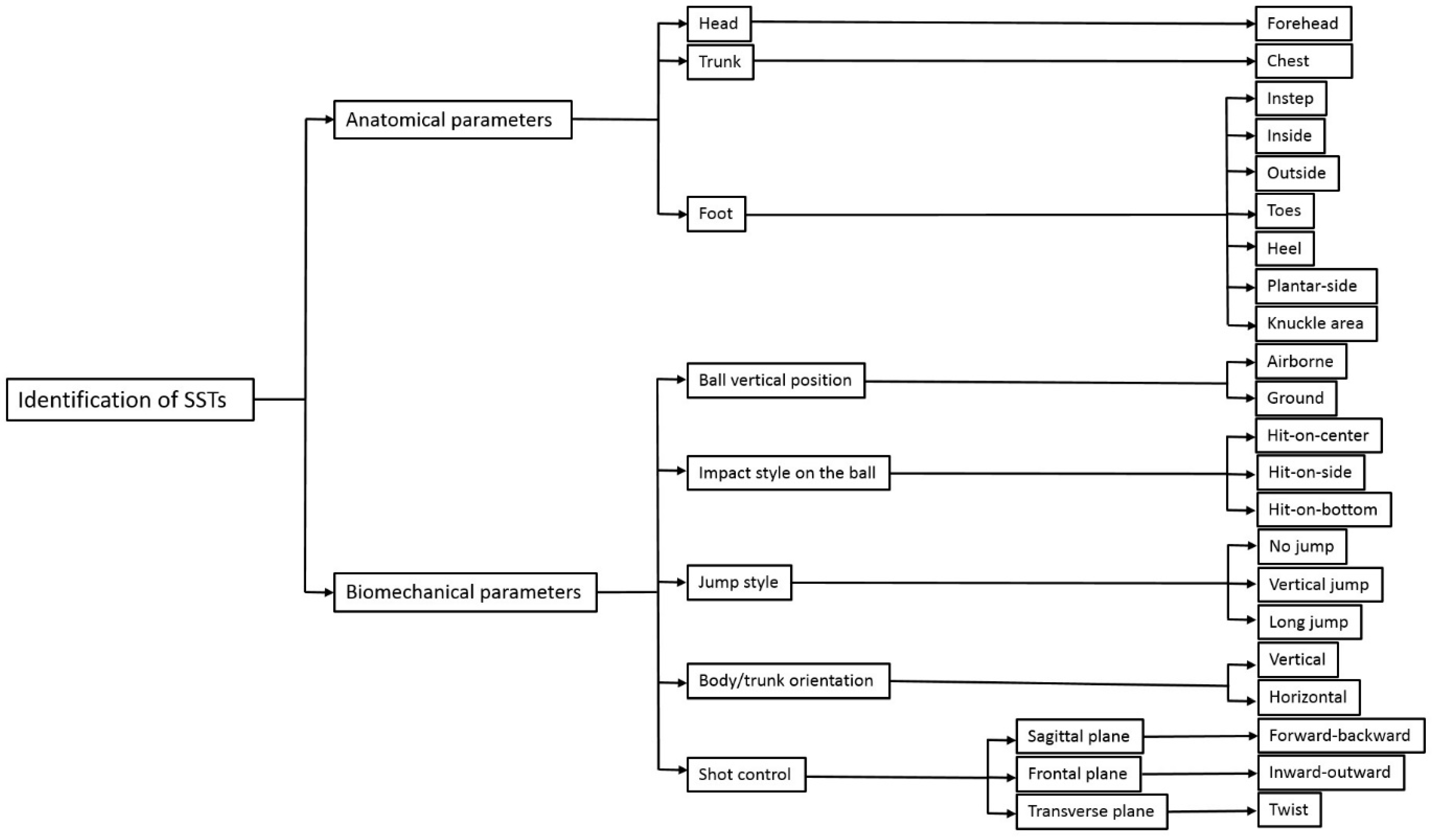
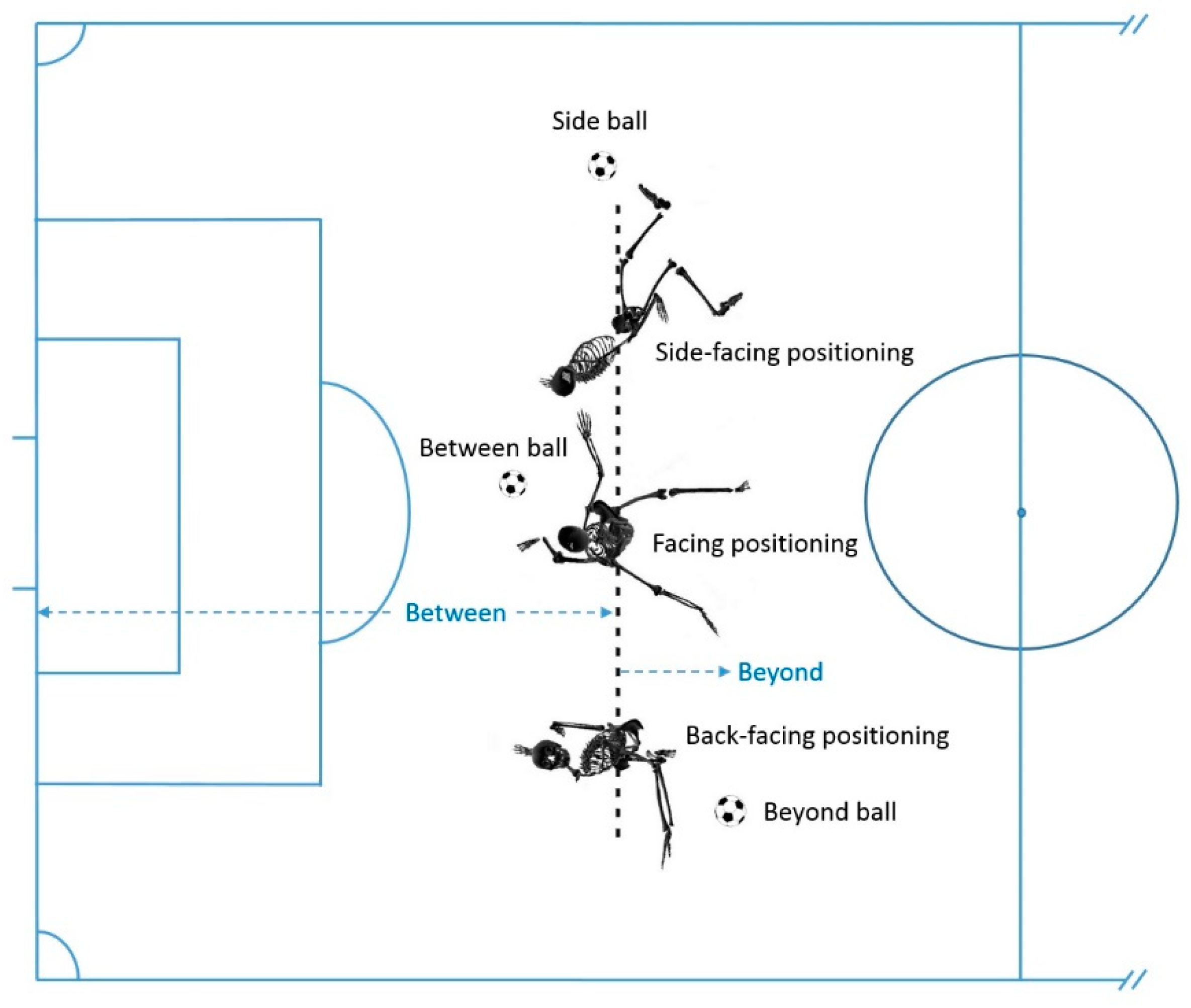
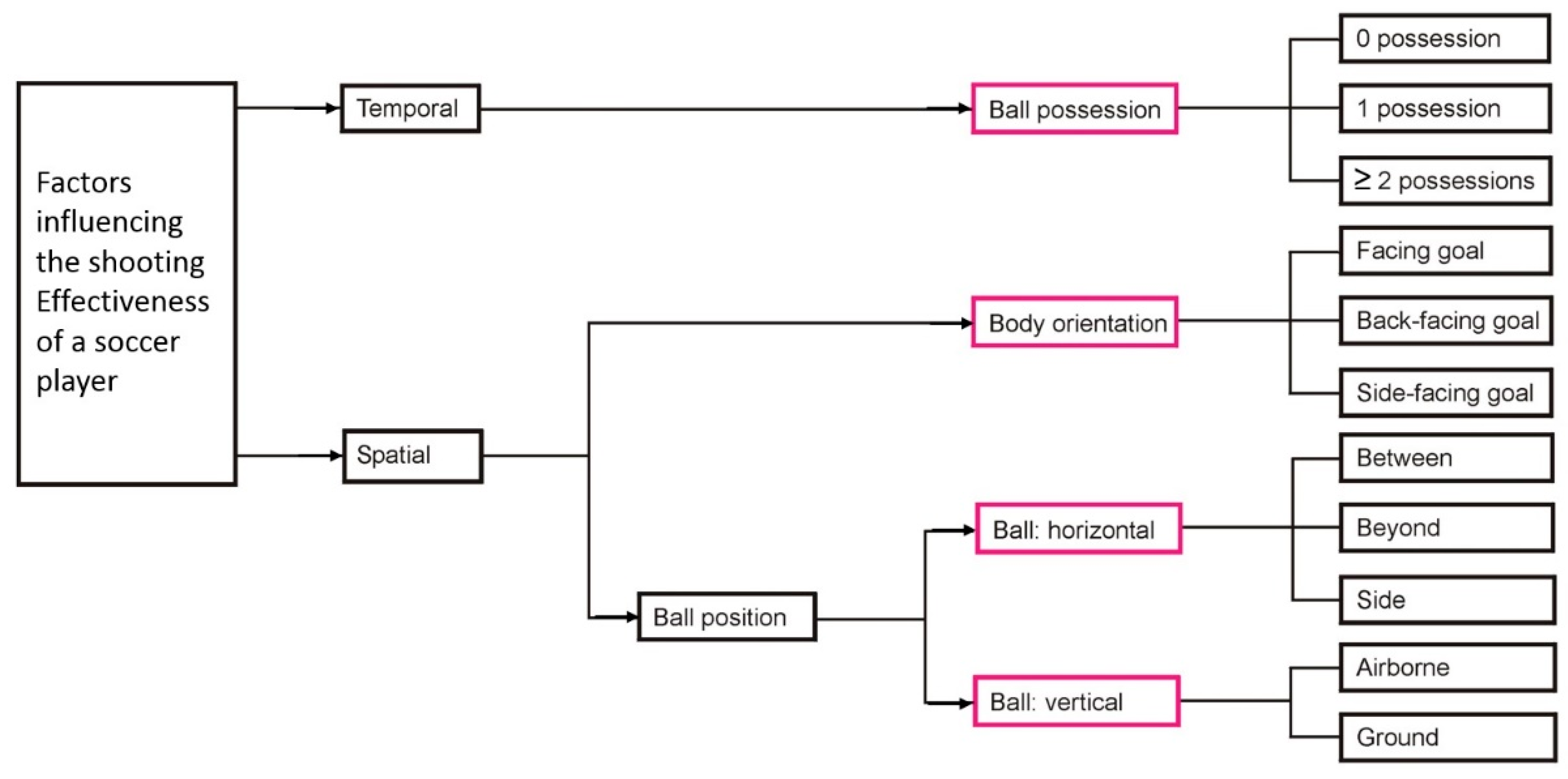
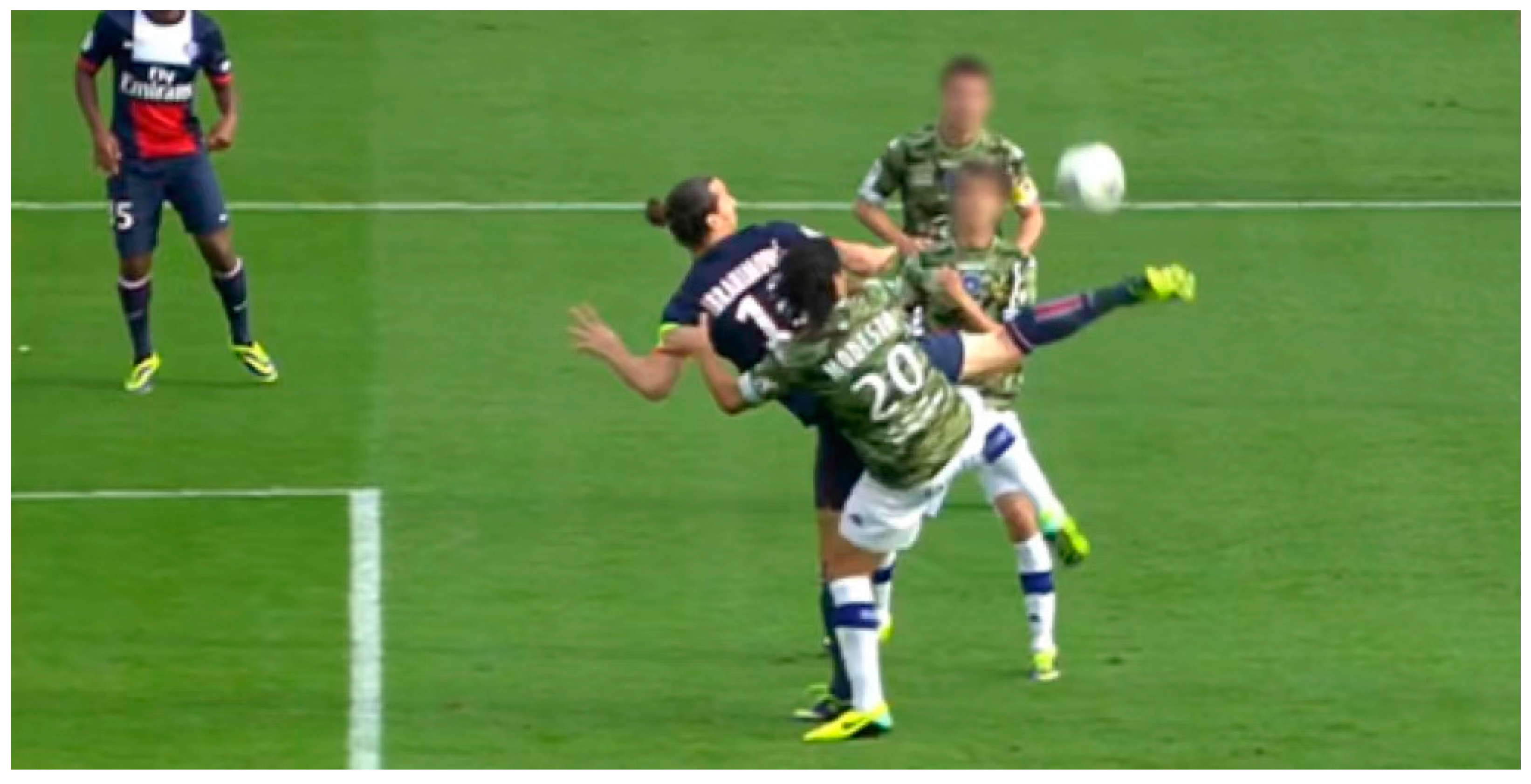
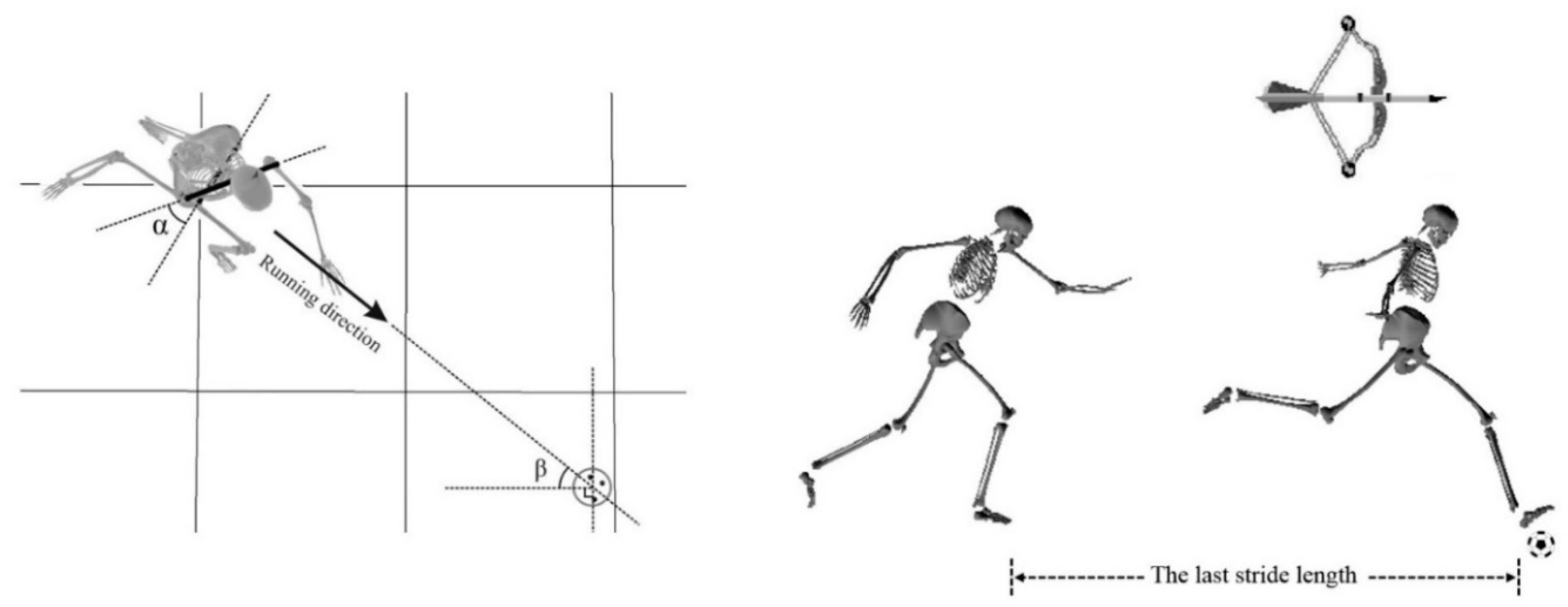
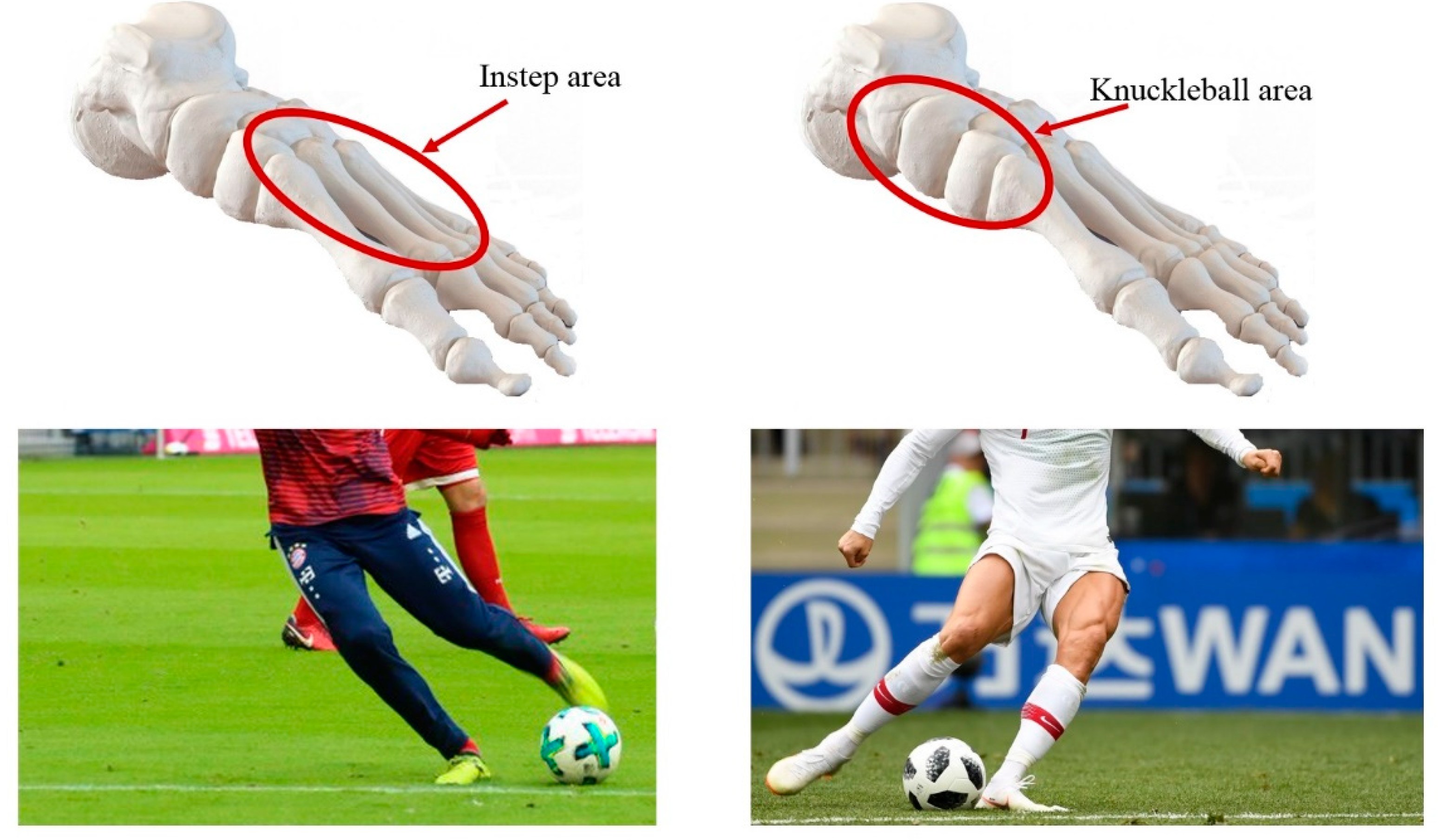
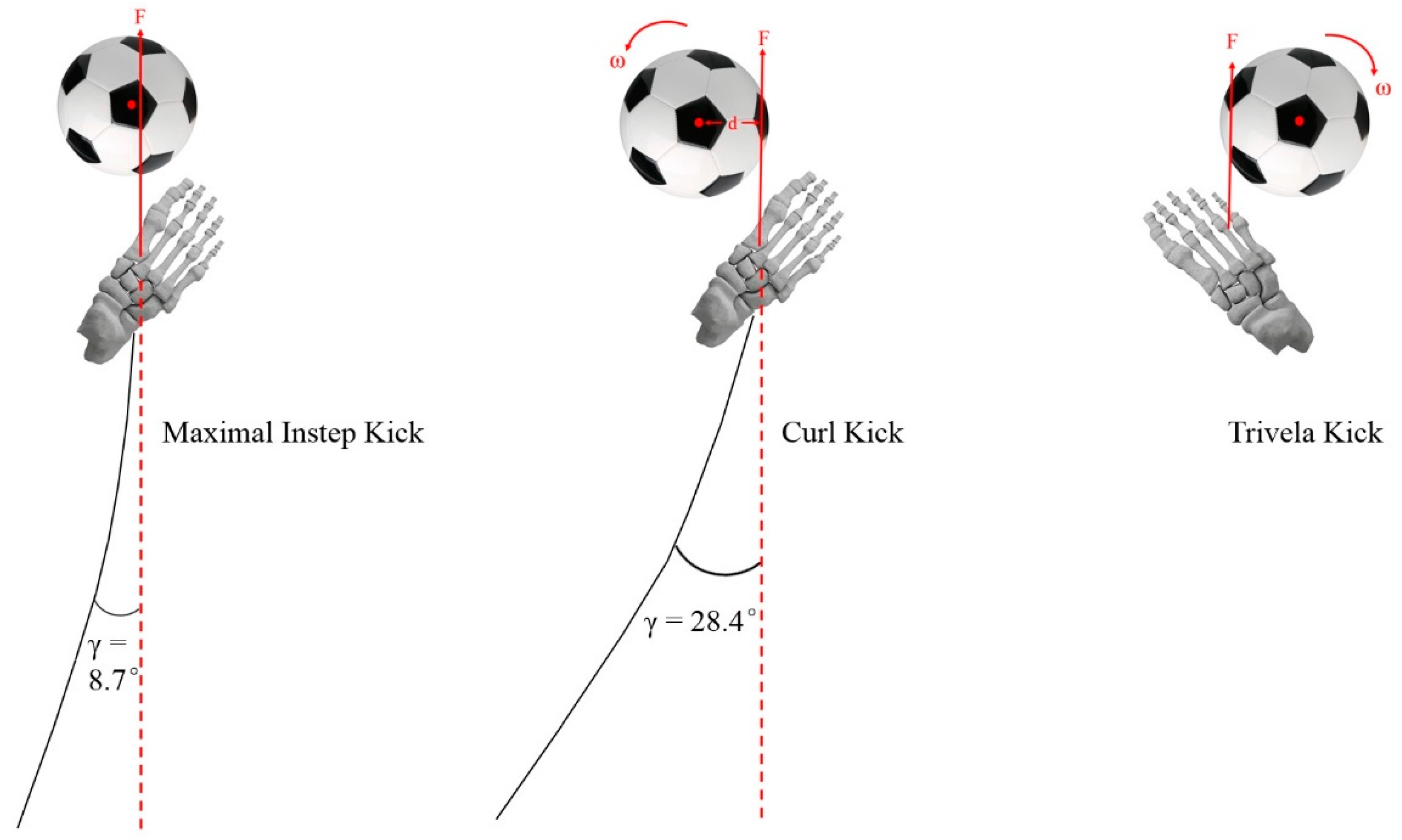

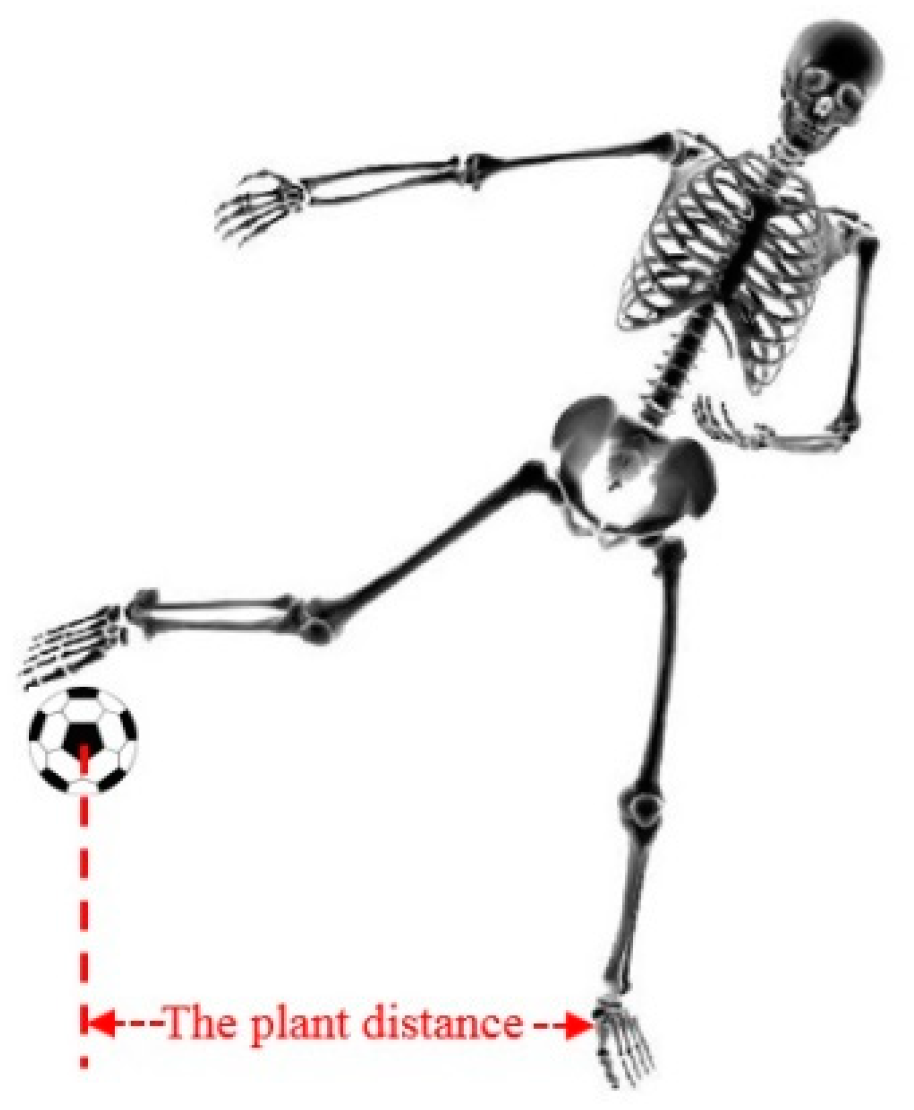



Publisher’s Note: MDPI stays neutral with regard to jurisdictional claims in published maps and institutional affiliations. |
© 2022 by the author. Licensee MDPI, Basel, Switzerland. This article is an open access article distributed under the terms and conditions of the Creative Commons Attribution (CC BY) license (https://creativecommons.org/licenses/by/4.0/).
Share and Cite
Shan, G. Soccer Scoring Techniques: How Much Do We Know Them Biomechanically?—A State-of-the-Art Review. Appl. Sci. 2022, 12, 10886. https://doi.org/10.3390/app122110886
Shan G. Soccer Scoring Techniques: How Much Do We Know Them Biomechanically?—A State-of-the-Art Review. Applied Sciences. 2022; 12(21):10886. https://doi.org/10.3390/app122110886
Chicago/Turabian StyleShan, Gongbing. 2022. "Soccer Scoring Techniques: How Much Do We Know Them Biomechanically?—A State-of-the-Art Review" Applied Sciences 12, no. 21: 10886. https://doi.org/10.3390/app122110886
APA StyleShan, G. (2022). Soccer Scoring Techniques: How Much Do We Know Them Biomechanically?—A State-of-the-Art Review. Applied Sciences, 12(21), 10886. https://doi.org/10.3390/app122110886







